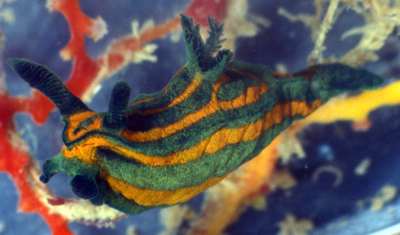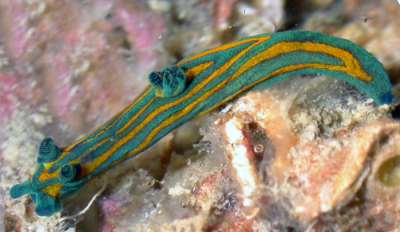

Tambja tentaculata
Pola, Cervera & Gosliner, 2005
Order: NUDIBRANCHIA
Suborder: DORIDINA
Superfamily: ANADORIDOIDEA
Family: Polyceridae
Subfamily: Nembrothinae
DISTRIBUTION
Described from Apra Harbor, Guam, but Forum records from Borneo and Indonesia show it is a wider dsitribution in the tropical Indo-West Pacific.
PHOTO
Upper:Apra Harbor, Western Shoals, Guam, 8 m; 11 July 2003. 20 mm. Carlson & Hoff -D.188. Found associated with the the red & yellow gorgonian (Acabaria?) in the background. Photo: Clay Carlson & Patty Jo Hoff. Lower: Apra Harbor, Western Shoals, Guam. Depth: 14 meters. Length: 17 & 20 mm alive. 15 September 2004. Photographer: Marta Pola.
The background colour of the body is green with several relatively broad longitudinal yellow bands. There are four dorsal yellow bands, two inner bands arising from the inside edge of the rhinophore sheaths and running back to the gills pocket, and two outer submarginal outer bands arising from the outside edge of the sheath. Tye submarginal bands run back behind the gill pocket and join in the posterior midline. There is also a short median yellow band that runs back a short distance from the gill pocket. From the base of the rhinophores, the submarginal yellow band on each side joins it counterpart on the other side in a loop around the anterior mantle, just in from the edge. On the sides of the body there is a yellow band just below the mantle which runs around the head, above the lateral slot and oral tentacles, and down each side of the body to near the posterior tip of the foot. A second band runs down the side of the body just in from the edge. These two lateral bands join each other near the posterior tip. They do not join their counterparts on the other side. In the photo available to me there is some distinct dark bluish pigmentation which along the distal edge of the oral tentacles, the edge of the rhinophore sheaths, and the extreme edge of the anterior mantle. The rhinophore club is also tinged with dark blue, and so are the gill pinnae. The edge of the yellow bands appears to be outlined by a thin dark line.
This species is unusual in having large elongate oral tentacles, more characteristic of a species of Roboastra than a species of Tambja. Its internal anatomy however is typical of Tambja. The only other species with similar oral tentacles is Tambja gratiosa from the western Atlantic. It is very similar in colour to Tambja olivaria [seen Tambja affinis colour group page for comparison].
-
Pola, M., Cervera, J.L. & Gosliner, T. (2005) Four New Species of Tambja Burn, 1962 (Nudibranchia: Polyceridae) from the Indo-Pacific. Journal of Molluscan Studies, 71: 257-267
Rudman, W.B., 2005 (August 17) Tambja tentaculata Pola, Cervera & Gosliner, 2005. [In] Sea Slug Forum. Australian Museum, Sydney. Available from http://www.seaslugforum.net/factsheet/tambtent
Related messages
-
Tambja tentaculata from Raja Ampat, Indonesia
From: Fiona Kwok, October 23, 2008 -
Tambja tentaculata from West Papua
From: Franco Banfi, June 6, 2007 -
Re: Tambja or Roboastra ? from Indonesia
From: Budi Ramadi Jerry, April 20, 2007 -
Re: Tambja tentaculata from Borneo
From: Teresa Zuberbühler, March 15, 2007 -
Re: Tambja or Roboastra ? from Indonesia
From: Marta Pola, May 9, 2006 -
Tambja or Roboastra? from Indonesia
From: Budi Ramadi Jerry, May 1, 2006 -
Tambja tentaculata from Bali
From: Hengky Dotulong, February 14, 2006 -
Tambja tentaculata from Borneo
From: Sylvain Le Bris, October 10, 2005 -
Tambja tentaculata - some more photos
From: Marta Pola, August 19, 2005 -
Tambja tentaculata from Guam
From: Clay Carlson & Patty Jo Hoff, August 18, 2005
